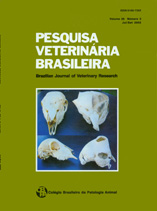 |
|
|
|
Year 2005 - Volume 25, Number 3
|

|
Intoxicação em suínos pela ingestão de sementes de Aeschynomene indica (Leg. Papilionoideae), p.135-142
|
Oliveira F.N., Rech R.R., Rissi D.R., Barros R.R. & Barros C.S.L. 2005. [Poisoning in swine from the ingestion of Aeschynomene indica (Leg.Papilionoideae) seeds.] Intoxica-ção em suínos pela ingestão de sementes de Aeschynomene indica (Leg. Papilionoideae). Pesquisa Veterinária Brasileira 25(3):135-142. Depto Patologia, Universidade Federal de Santa Maria, 97105-900 Santa Maria, RS, Brazil. E-mail: claudioslbarros@uol.com.br
A spontaneous outbreak of a neurological disease in swine caused by the ingestion of Aeschynomene indica seeds and the reproduction of the disease in the same animal species are reported. The natural outbreak occurred in a pig-raising facility in the central region of the state of Rio Grande do Sul, Brazil. On the premises there were 100 pigs (20 breeding sows and 80 young weaned pigs from several categories) that were fed a ration made by mixing 50% of corn bran, 25% of soybean bran, 5% of a commercial mix of vitamins and minerals, and 20% of broken rice contaminated with 40% of A. indica seeds. Although all pigs apparently ingested the same ration, only 45-day-old pigs were affected; morbidity, mortality and lethality rates were respectively 25%-40%, 8.5%-20%; and 25%-66%. Clinical signs appeared 24 hours after the beginning of feeding of A. indica seeds contaminated ration and included variable degrees of incoordinated gait, falls, sternal recumbency with the hind limbs in a wide base stance, lateral recumbency and death. It was not possible to ascertain how many pigs recovered nor the time frame of recovery. One pig was euthanatized and necropsied in the premises. The poisoning was reproduced in 5 young pigs (A-E) which were fed a ration containing 10% (Pig A), 15% (Pig B) and 20% (Pigs C-E) of A. indica seeds, and in one older pig (Pig F) which was fed a ration with 16.5% of A. indica seeds. Pigs A, B and F were euthanatized and Pigs C-E died of an acute disease respectively 16, 21 and 24 hours after the beginning of the experiment. Clinical signs were similar to those observed in pigs of the spontaneous outbreak. Necropsy findings included marked hyperemia of the encephalic leptomeninges of all pigs; there were large amounts of A. indica seeds in the stomach and reddening of the intestinal wall and bloody intestinal content in Pigs C-E. A hematoma was observed in the lungs of Pig C. The histopathological findings in the brain of pigs fed rations with larger concentrations (20%) of A. indica seeds (C-E) included congestion, edema and hemorrhage and swollen vascular endothelia with focal symmetrical distribution in several brain nuclei and in the telencephalic cortex. In Pigs A and B, and in Pig F, the case which received the lower dosage of the seeds of A. indica, and in the pig from the spontaneous outbreak, histopathological changes in the brain consisted of discrete focal symmetrical areas of malacia in which closely packed Gitter cells and astrocytosis, and capillaries with swollen endothelium obliterated the normal neuropil. The symmetrical malacic foci caused by the ingestion of A. indica seeds in swine affected cerebellar and vestibular nuclei, putamen, and the mesencephalic oculomotor and red nuclei. This indicates that the A. indica seeds ingestion was responsible for the neurological condition, that it may be fatal and seems to affect equally young and older swine. The clinical outcome and pathological changes were dose-dependent, and the brain lesions progressed from damaged blood vessels to vasogenic edema, hemorrhage and malacia. |
| |
|
|
| |
|
 |